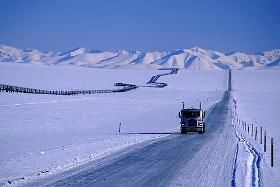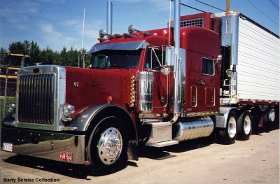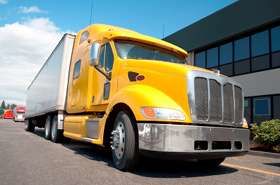Bridge Law Chart.. Rand Mcnalley
Topic 14115 | Page 1

Bridge law: W=500(L*N/(N-1) + 12*N + 36) where W = weight permitted in pounds, L = distance between outer axles of a set of axles, N = number of axles. W is rounded to the nearest 500 lbs
If you have two drives axles on a tractor and trailer with a moveable tandem your axle weights allow 68,000#, so solving for
68000<500(L*4/(3) + 48 + 36)
we get L > 39.
Any distance between tractor and trailer tandems that's greater than 39 feet is legal. Is 41' from kingpin to rear axle greater than 39'?
Tandems:
Tandem Axles
A set of axles spaced close together, legally defined as more than 40 and less than 96 inches apart by the USDOT. Drivers tend to refer to the tandem axles on their trailer as just "tandems". You might hear a driver say, "I'm 400 pounds overweight on my tandems", referring to his trailer tandems, not his tractor tandems. Tractor tandems are generally just referred to as "drives" which is short for "drive axles".
Tandem:
Tandem Axles
A set of axles spaced close together, legally defined as more than 40 and less than 96 inches apart by the USDOT. Drivers tend to refer to the tandem axles on their trailer as just "tandems". You might hear a driver say, "I'm 400 pounds overweight on my tandems", referring to his trailer tandems, not his tractor tandems. Tractor tandems are generally just referred to as "drives" which is short for "drive axles".

Ha, I didn't put in the calculations for the whole truck:
80000<500(L*5/(4) + 60 + 36)
what's the shortest distance allowed between steers and the rear axle of the trailer?
The one and likely only time I'll ever need/want Errol around... and I can't find him!

7th grade dropout here.
Could you make that just a LITTLE SIMPLER?
Like - "common core simple"?
Wouldn't it be safe to assume, with your axles legal at the particular states "kingpin to tandem distance", that you would also be "bridge law legal" - as the gross weights for bridges (for a particular jurisdiction) are based on max-gross (80K) at legal kingpin distances?
Rick
Tandem:
Tandem Axles
A set of axles spaced close together, legally defined as more than 40 and less than 96 inches apart by the USDOT. Drivers tend to refer to the tandem axles on their trailer as just "tandems". You might hear a driver say, "I'm 400 pounds overweight on my tandems", referring to his trailer tandems, not his tractor tandems. Tractor tandems are generally just referred to as "drives" which is short for "drive axles".

óti eínai Éllines gia ména :-)
So it looks to me (reading that page linked above) that if tandem hole 1 leaves at least 36 feet between the front drive tire and the rear axle, then you would always be "bridge law legal".
Tandem:
Tandem Axles
A set of axles spaced close together, legally defined as more than 40 and less than 96 inches apart by the USDOT. Drivers tend to refer to the tandem axles on their trailer as just "tandems". You might hear a driver say, "I'm 400 pounds overweight on my tandems", referring to his trailer tandems, not his tractor tandems. Tractor tandems are generally just referred to as "drives" which is short for "drive axles".
...and I don't know if it does or not, I guess I was thinking that maybe they make the trailer so the tandems can't go so far forward that you would be illegal.
Tandems:
Tandem Axles
A set of axles spaced close together, legally defined as more than 40 and less than 96 inches apart by the USDOT. Drivers tend to refer to the tandem axles on their trailer as just "tandems". You might hear a driver say, "I'm 400 pounds overweight on my tandems", referring to his trailer tandems, not his tractor tandems. Tractor tandems are generally just referred to as "drives" which is short for "drive axles".
Tandem:
Tandem Axles
A set of axles spaced close together, legally defined as more than 40 and less than 96 inches apart by the USDOT. Drivers tend to refer to the tandem axles on their trailer as just "tandems". You might hear a driver say, "I'm 400 pounds overweight on my tandems", referring to his trailer tandems, not his tractor tandems. Tractor tandems are generally just referred to as "drives" which is short for "drive axles".
The one and likely only time I'll ever need/want Errol around... and I can't find him!
What!? I saw this at lunch time and figured Michael had it worked out. I didn't want to butt in on his show.
And I never figured out what the bridge law thing was all about.
@Michael, with this crowd, don't say "solve for L". Just say " Re-write the inequality to get L":
L > {(N-1)/N} {W/500 - 12N - 36}
Again, just as clear as pea soup! Might as well say "я не должен научить вас плохих русских слов."

Frito, so for you to bridge out the truck you need to now the distens from stear axel to the last drive axel. Distense between both drive axels. Drive axels to trailer axels and distense between trailer axels, then the total length, all three have to bridge out, not just one set. Clear as mud? Kingpin settling are not the same as bridging a truck out. King pins are state manded settings and bridge formula is Federal. So if you can't get the bridge and kingpin to work witch one do you fallow?
New Reply:
New! Check out our help videos for a better understanding of our forum features

















Preview:
This topic has the following tags:
Bridge Heights DOT Truck Equipment Understanding The Laws Weight and Scales







 TT On Facebook
TT On Facebook
Editor's Note: We have an excellent resource that will help you understand The Bridge Law and Axle To Kingpin Spacing so check that out.
So I visited one of our company cookouts today and attended the safety meeting offered. I approached the safety guru after the meeting to gain some clarity on the bridge law versus the states kingpin spacing requirements. While asserting that they were two different concepts and seeking advice on just how to affirm that post scale I am " bridge law legal" he got short with me stating that the kingpin distance and bridge laws were the same thing and that if I wanted to give the concept so much thought perhaps I shouldn't have gotten into trucking. I'm seeking advice on how to apply the chart on page A15 of the atlas to my standard semi-trailer set up. I'm finding it a bit confusing. When I pop off the cat scale I want to be able to quickly reference this chart and my 41' mark and be able to say with confidence... Yep I'm legal. Thanks for any insight/advice.
CDL:
Commercial Driver's License (CDL)
A CDL is required to drive any of the following vehicles:
Tandem:
Tandem Axles
A set of axles spaced close together, legally defined as more than 40 and less than 96 inches apart by the USDOT. Drivers tend to refer to the tandem axles on their trailer as just "tandems". You might hear a driver say, "I'm 400 pounds overweight on my tandems", referring to his trailer tandems, not his tractor tandems. Tractor tandems are generally just referred to as "drives" which is short for "drive axles".
CAT Scale:
A network of over 1,500 certified truck scales across the U.S. and Canada found primarily at truck stops. CAT scales are by far the most trustworthy scales out there.
In fact, CAT Scale offers an unconditional Guarantee:
“If you get an overweight fine from the state after our scale showed your legal, we will immediately check our scale. If our scale is wrong, we will reimburse you for the fine. If our scale is correct, a representative of CAT Scale Company will appear in court with the driver as a witness”